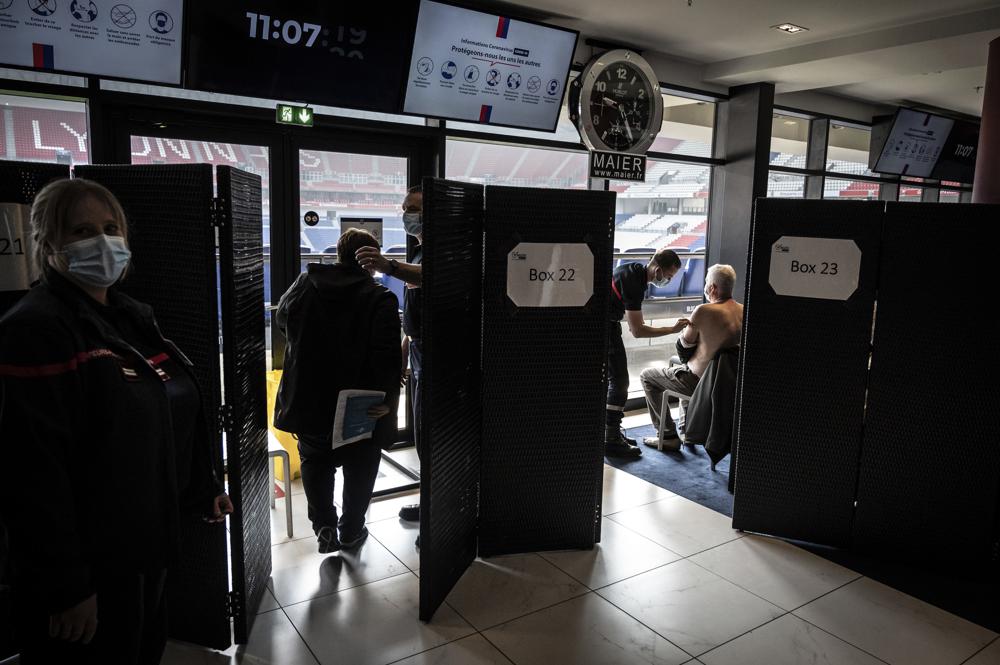Prince Harry declares US home, renounces British residency
Prince Harry officially makes the United States his primary residence, renouncing ties to the UK royal family in a significant move.
The slowdown of the United States’s once-vaunted campaign has contributed to the virus’s deadly comeback.

In this file photo dated Saturday, April 3, 2021, patients receive an injection of the Moderna Covid-19 vaccine on the opening day of a mass vaccination centre set up in the Olympique Lyonnais soccer Stadium, in Decines-Charpieu, France.
Despite a sluggish start, the European Union’s Covid-19 vaccination drive has caught up to that of the United States, where the slowdown of the country’s once-vaunted campaign has contributed to the virus’s deadly comeback.
In mid-February, less than 4% of people living in the 27-nation EU were at least partially vaccinated against the coronavirus, compared with nearly 12% in the U.S, according to Our World in Data, an online science publication connected to the University of Oxford.
Now the EU has surpassed the U.S. by that same measure, with some 60% of the bloc’s residents receiving at least one dose, versus less than 58% of Americans. In Italy, where roughly 63% of people 12 and older are fully protected, Premier Mario Draghi took a victory lap this past week.
Advertisement
“I said that I don’t want to celebrate successes, but it must be said that Italy has inoculated more doses per 100 inhabitants than France, Germany, the United States,” he said as the country’s vaccine verification program went into effect Friday.
People in Italy must now show proof they have had at least one vaccine dose, recovered from COVID-19 or recently tested negative for the virus if they want to dine indoors, use gyms or go to concerts, theaters, museums and tourist sites such as the Colosseum.
European authorities attribute success in Italy and elsewhere to nationalized health care and a history of public confidence in the safety of immunizations.
The EU’s slow process for approving the vaccinations set the bloc back at the beginning, but that is now paying dividends because it is instilling more confidence in the rapidly developed formulas, said Dr. Peter Liese, a European Parliament member from Germany.
While the U.S. and Britain issued emergency authorizations of vaccines to get shots into arms quickly, the EU went through the long process of granting full approvals, putting it weeks behind.
“I am convinced that we have a good argument to explain to people still hesitating that the vaccine was properly tested in Europe,” Liese said recently. “Now it becomes clear that not only the pace of vaccination in the first months but also the long-term strategy is important.”
The turnaround in Spain has been pronounced. In mid-April, when nearly a quarter of all Americans were fully vaccinated, only 7% of Spaniards were similarly protected, according to Our World in Data. Now, nearly 60% of Spain’s roughly 47 million people are fully vaccinated, while about half the U.S. is.
Portugal, with around 10 million people, had fully vaccinated around a third of its population by the end of June. Now officials say it is on track to reach 70% by the end of the summer.
The major factor holding back the EU initially was its decision to purchase vaccines as a bloc instead of as individual countries. The move ensured smaller member nations weren’t left out, but it ended up taking more time to negotiate with pharmaceutical companies.
Meanwhile, the U.S. vaccination effort peaked and then dropped off dramatically in the face of significant hesitancy and outright hostility, fueled by misinformation and partisan politics.
(With AP inputs)
Advertisement